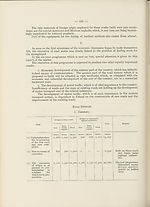Download files
Complete book:
Individual page:
Thumbnail gallery: Grid view | List view

— 167 —
II.
In general, the administrative methods followed in regard to the execution of the
road bridges are the same as those employed in regard to the roads themselves.
The works are executed :
(1) On behalf of the public authorities, under the supervision of their own
specially appointed engineers, or else, in the case of ordinary bridges, under the
supervision of the district heads of the Road Administration;
(2) By commercial undertakings, the contracts being awarded on the basis of
public tenders.
III.
The financial methods employed are the same as in the case of the roads.
IV.
The material and equipment (almost all of national origin) represent 62 %, and
labour directly employed 38 %, of the total expenditure.
V.
As regards the effects of this work on economic and industrial activity and on unem¬
ployment, what has already been said in regard to road works also applies in the case of
bridges.
(b) RAILWAY UNES.
I.
Railway works represent one of the most important categories of public works.
The scheme of capital investment on the railways comprises works on the construction
of a certain number of new lines and connections, the improvement of already existing
lines, and the repair of damage done during the war.
As regards the execution of this programme :
(a) During the last five-year period—viz., from the beginning of 1929 to the end
of 1933—the more important railway works were completed—viz. :
At a total cost of approximately 229 million zloty, 600 kilometres of new lines have
been built. The most important of the new lines is that connecting the Upper Silesian
coalfield with the port of Gdynia; it is 458 kilometres long and is intended more
particularly for the transport of coal.
A great deal of money has been laid out on the existing railways with a view to
increasing their traffic capacity and safety—viz., the construction of second tracks, the
rebuilding of stations and junctions, the construction of shunting tracks, haulage instal¬
lations, railway tanks, and appliances for ensuring safety of operation, etc.—representing
in all an outlay of 246 million zloty. One of the most important of these works was the
reconstruction of the Warsaw Junction, which was completed in 1933, at a cost of approxi¬
mately 80 million zloty; in its first phase, this undertaking included the opening of a
double-track line, 7 kilometres long, connecting the railway system on the right bank of
the Vistula with that on the left.
II.
In general, the administrative methods followed in regard to the execution of the
road bridges are the same as those employed in regard to the roads themselves.
The works are executed :
(1) On behalf of the public authorities, under the supervision of their own
specially appointed engineers, or else, in the case of ordinary bridges, under the
supervision of the district heads of the Road Administration;
(2) By commercial undertakings, the contracts being awarded on the basis of
public tenders.
III.
The financial methods employed are the same as in the case of the roads.
IV.
The material and equipment (almost all of national origin) represent 62 %, and
labour directly employed 38 %, of the total expenditure.
V.
As regards the effects of this work on economic and industrial activity and on unem¬
ployment, what has already been said in regard to road works also applies in the case of
bridges.
(b) RAILWAY UNES.
I.
Railway works represent one of the most important categories of public works.
The scheme of capital investment on the railways comprises works on the construction
of a certain number of new lines and connections, the improvement of already existing
lines, and the repair of damage done during the war.
As regards the execution of this programme :
(a) During the last five-year period—viz., from the beginning of 1929 to the end
of 1933—the more important railway works were completed—viz. :
At a total cost of approximately 229 million zloty, 600 kilometres of new lines have
been built. The most important of the new lines is that connecting the Upper Silesian
coalfield with the port of Gdynia; it is 458 kilometres long and is intended more
particularly for the transport of coal.
A great deal of money has been laid out on the existing railways with a view to
increasing their traffic capacity and safety—viz., the construction of second tracks, the
rebuilding of stations and junctions, the construction of shunting tracks, haulage instal¬
lations, railway tanks, and appliances for ensuring safety of operation, etc.—representing
in all an outlay of 246 million zloty. One of the most important of these works was the
reconstruction of the Warsaw Junction, which was completed in 1933, at a cost of approxi¬
mately 80 million zloty; in its first phase, this undertaking included the opening of a
double-track line, 7 kilometres long, connecting the railway system on the right bank of
the Vistula with that on the left.
Set display mode to:
![]() Universal Viewer |
Universal Viewer | ![]() Mirador |
Large image | Transcription
Mirador |
Large image | Transcription
Images and transcriptions on this page, including medium image downloads, may be used under the Creative Commons Attribution 4.0 International Licence unless otherwise stated. ![]()
| League of Nations > Communications and transit > Enquiry on national public works > (169) |
|---|
| Permanent URL | https://digital.nls.uk/195000547 |
|---|
| Shelfmark | LN.VIII |
|---|
| Description | Over 1,200 documents from the non-political organs of the League of Nations that dealt with health, disarmament, economic and financial matters for the duration of the League (1919-1945). Also online are statistical bulletins, essential facts, and an overview of the League by the first Secretary General, Sir Eric Drummond. These items are part of the Official Publications collection at the National Library of Scotland. |
|---|---|
| Additional NLS resources: |
|

